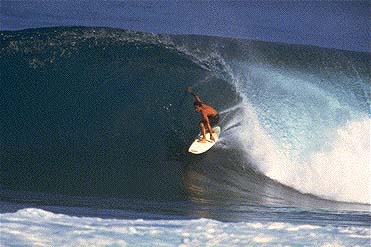 Mixed Plate Mixed Plate
Wave Height
This is another story from my friend Danny Z. Clark of Central Cal. Enjoy!
Wave Height

[How big is this one, Mr. Senator?]
Official Transcript from the Senate Sub-committee on
Wave Heights. The meeting was called to order at 9:30 am.
Committee members present:
Jim Paymemore-D Utah,
Frank Swindle-R Ohio,
William Huckster-D Maine
Paymemore: Let's begin this meeting by introducing our
expert witnesses that have kindly given of their time to
be with us today. From Hawaii we have Kiko Kamahana,
from San Calamity California we have Jimmy X and from
Cuckoo Beach Florida we have Jon Ronny. Senator Huckster,
could you bring us up to speed on the problems as you see it.
Huckster: Well the problem is there is not a standard way to
measure wave heights. A 2 ft. wave in Hawaii might be called
a 4 ft. wave in California and a double overhead monster on
the East Coast.
Swindle: How could this be? How many ways can there be to
measure a wave?
Huckster: Why don't we let our experts explain how they measure
waves. We will start with Mr. X from California.
X: On the west coast we measure the wave by how high the
face is just before it breaks. We judge the height by comparing
it to the oil platforms just offshore. Another method we use is
by how hard it is to find a parking place. For every five minutes
you look for a place to park, add one foot to the wave height.
Huckster: Very good Mr. X, now lets hear from Mr. Ronny from Florida.
Ronny: The right way to measure wave heights is with a ruler.
Usually a one foot ruler will do, but during the Hurricane season
we pull out the old yard stick. You just walk out into the waves
and stop when your ankles get wet. Then push the ruler as deep
into the sand as you can. Then just step back and wait for the
next set wave to come crashing in. If the wave covers the ruler,
then it was over one foot. Any thing else we measure in inches,
although I heard that some guys in Virginia Beach were using the
metric system, with wave heights in millimeters.
Huckster: Well that's very interesting, now Mr.. Kamahana, will you
bring us up to speed on the Hawaiian method of measuring wave heights ?
Kamahana: The right way to measure waves is from the back of
the wave.
Swindle: How do you do that when you can't see the back of a wave ?
Kamahana: Well, we don't actually measure the back of the
wave, we use something called the inverse haole formula. The
formula is 1/H * 50 = wave height, where H = the number of
haoles out at our local break.
Huckster: So let me see if I got this right, if there are 50 haoles
out, then 1/50 * 50 would equal a 1 ft. wave.
Kamahana: You got it bro, and if there is only 2 haoles out, we
have a 25 ft. monster!
Huckster: Well then gentlemen, as you can see we have a problem
as to which of these methods if any should be adopted as the
official wave height index.
Paymemore: I move that we adjourn this meeting and re-convene
in Hawaii next week for an extended stay so that we study the
problem first hand.
Swindle: I second the motion, this meeting stands adjourned.

|